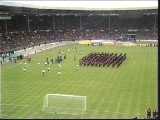 This feature is not about football or soccer itself (there are lots of other sites catering for football fans), but these pictures of the match between England and Scotland that took place at Wembley Stadium on 26 May 1979 help illustrate the BBC’s style of television presentation of football matches during the late 1970s/early 1980s, including the various on-screen captions that were used.
This feature is not about football or soccer itself (there are lots of other sites catering for football fans), but these pictures of the match between England and Scotland that took place at Wembley Stadium on 26 May 1979 help illustrate the BBC’s style of television presentation of football matches during the late 1970s/early 1980s, including the various on-screen captions that were used.
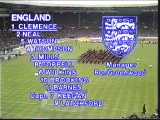 This comprehensive graphic display was used for team details at the start of the match together with the team’s crest. The England team of this era featured famous players such as Kevin Keegan, Steve Coppell and Trevor Brooking who was later to become a familiar face on BBC1 as a football pundit.
This comprehensive graphic display was used for team details at the start of the match together with the team’s crest. The England team of this era featured famous players such as Kevin Keegan, Steve Coppell and Trevor Brooking who was later to become a familiar face on BBC1 as a football pundit.
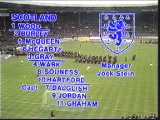 And ditto for the opposing team – in this case Scotland.
And ditto for the opposing team – in this case Scotland.
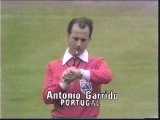 The referee (Antonio Garrido, from Portugal) was deemed important enough to have an on-screen caption all of his own. He checks his watch, waiting for play to begin.
The referee (Antonio Garrido, from Portugal) was deemed important enough to have an on-screen caption all of his own. He checks his watch, waiting for play to begin.
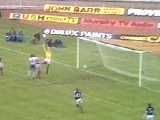 This (enlarged) view of the goal mouth shows some of the advertisement hoardings used at the time. Note the advertisements for Bush and Murphy – two electrical brand names that were prominent in the 1970s – the Bush brand is now owned by Sainsbury’s who own the chain of Argos catalogue shops in the UK and Ireland, amongst other concerns.
This (enlarged) view of the goal mouth shows some of the advertisement hoardings used at the time. Note the advertisements for Bush and Murphy – two electrical brand names that were prominent in the 1970s – the Bush brand is now owned by Sainsbury’s who own the chain of Argos catalogue shops in the UK and Ireland, amongst other concerns.
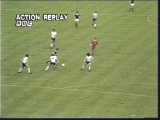 The advent of video disc recording in 1968 meant that action replays (including slow motion and still frames without any interference) were possible without any delay involved in rewinding a videotape, though this was confined only to the last 33 seconds of play which was being recorded in a continuous loop. The BBC showed briefly an onscreen caption (which included the BBC logo) at the beginning of the replay to let viewers know what they were watching; not long afterwards – well at least by January 1980 – this reminder was used far less often presumably because viewers had been long accustomed to this sort of thing.
The advent of video disc recording in 1968 meant that action replays (including slow motion and still frames without any interference) were possible without any delay involved in rewinding a videotape, though this was confined only to the last 33 seconds of play which was being recorded in a continuous loop. The BBC showed briefly an onscreen caption (which included the BBC logo) at the beginning of the replay to let viewers know what they were watching; not long afterwards – well at least by January 1980 – this reminder was used far less often presumably because viewers had been long accustomed to this sort of thing.
 When something of note happened during the game (such as a goal being scored) a caption would often briefly appear identifying the person involved – in this case Peter Barnes who scored the equalising goal for England shortly before the half-time whistle.
When something of note happened during the game (such as a goal being scored) a caption would often briefly appear identifying the person involved – in this case Peter Barnes who scored the equalising goal for England shortly before the half-time whistle.
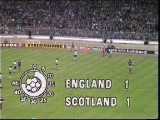 These were the days before the occasional use of a permanent on-screen display of the current score – viewers had to keep track of the game themselves for much of the time, in which case you had to be watching from the start or have a friend tell you the score. Hence this graphic was very important when it appeared – it also incorporated a football-shaped clock with a white band indicating elapsed time since the start of play.
These were the days before the occasional use of a permanent on-screen display of the current score – viewers had to keep track of the game themselves for much of the time, in which case you had to be watching from the start or have a friend tell you the score. Hence this graphic was very important when it appeared – it also incorporated a football-shaped clock with a white band indicating elapsed time since the start of play.
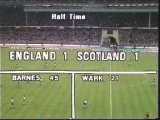 At the end of half (or full) time this noticeboard-style caption was used which helpfully gave details of who scored what goals and when. Also note the absence of any form of electronic scoreboard or large screen display(s) in the stadium which are so common today.
At the end of half (or full) time this noticeboard-style caption was used which helpfully gave details of who scored what goals and when. Also note the absence of any form of electronic scoreboard or large screen display(s) in the stadium which are so common today.
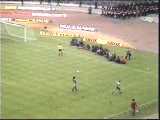 The marching band (a regular fixture during the interval to ‘entertain’ the crowd during and before this period) barely had the chance to leave the pitch when play started again!
The marching band (a regular fixture during the interval to ‘entertain’ the crowd during and before this period) barely had the chance to leave the pitch when play started again!
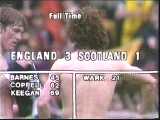 Match over – Ron Greenwood’s England team had beaten Jock Stein’s Scotland (something that wasn’t entirely expected) and the team captains (Dalglish and Keegan) swapped shirts.
Match over – Ron Greenwood’s England team had beaten Jock Stein’s Scotland (something that wasn’t entirely expected) and the team captains (Dalglish and Keegan) swapped shirts.